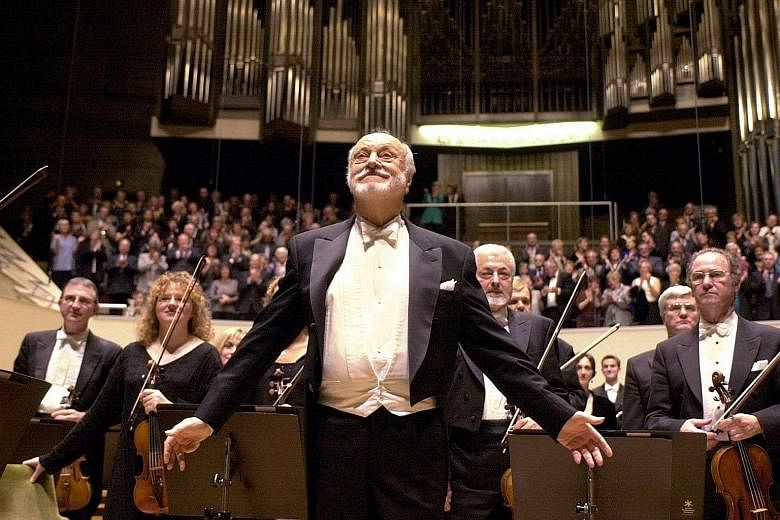NEW YORK • Kurt Masur, the German conductor who revitalised the New York Philharmonic and used his singular renown to avert mass bloodshed when communism began to crumble in East Germany, died last Saturday in Greenwich, Connecticut. He was 88.
The death, from complications of Parkinson's disease, was announced by the Philharmonic.
Masur, its music director from 1991 to 2002, was credited with transforming the orchestra from a sullen, lacklustre ensemble into one of luminous renown.
What The New York Times called "his finest hour, and a gift to the city" came on Sept 20, 2001. That night, in a nationally televised memorial to the victims of the Sept 11 attacks, Masur led the Philharmonic in a performance of Brahms' German Requiem.
"Kurt Masur's unabashed belief in the power of music to make big statements and foster healing has sometimes invited kidding," Anthony Tommasini, reviewing the concert, wrote in The Times. "No longer."
Masur was born on July 18, 1927, in Brieg. The town, then in the Silesian region of Germany, is now Brzeg, Poland. His father was an engineer and, at his pragmatic insistence, young Kurt studied to become an electrician. But he also studied music, training as a pianist, organist, cellist and percussionist.
After spending more than a decade leading orchestras and opera companies throughout the newly formed East Germany, he became the music director of the Komische Oper, Berlin. He was later chief conductor of the Dresden Philharmonic, a post he held from 1967 to 1972. In 1970, he was named Kapellmeister of the Gewandhaus, one of Europe's most venerable orchestras. He would hold that post for 26 years.
Though he was not a member of the Communist Party, his prowess as a conductor gained him great favour with its leadership. He had a comfortable home in Leipzig and, in an era when an average citizen might wait more than a decade for a chance to buy a Trabant, the East German automobile, he drove a Mercedes.
He was also permitted to accept guest-conducting invitations from around the world, including the New York and Israel Philharmonics.
The popular revolt against East German communism started in Leipzig, taking hold there in October 1989.
Masur's immersion had begun a few months before, when he was asked to lend his support to the city's street musicians, who were routinely arrested for not holding official licences.
At considerable professional risk, he convened a meeting at the Gewandhaus, inviting the musicians; the Stasi, the East German secret police; and Communist Party officials - more than 600 people in all. It was a measure of his influence that everyone came and that an amicable meeting ensued, with the restrictions on street musicians eased.
He would deploy his diplomatic skills even more forcefully in October. That month, pro-democracy demonstrations began in Leipzig's Karl-Marx-Platz, which the Gewandhaus overlooked. Armed police officers stood ready to meet them. Once again, Masur invited everyone for talks. He recorded a message, broadcast by radio and over loud speakers, urging non-violence. Both sides heeded his words and the day's events helped set in motion a peaceful nationwide revolution.
His work was widely seen as helping avert another Tiananmen Square. As a result, leaders of post- communist, pre-reunification East Germany considered nominating him for the country's presidency.
Then came the offer from the New York Philharmonic. "Kurt," English conductor Simon Rattle advised him, "don't be under any illusions which would be more difficult."
Masur chose the harder job and left for New York. His immediate predecessors - Pierre Boulez, with his cerebral approach and focus on contemporary works, and Zubin Mehta, seen as purveying flash and dazzle at the expense of deep musical meaning - were held responsible for the artistic decline that had followed the epochal reign of Leonard Bernstein.
At first, many players viewed his relentless work ethic as a form of tyranny. What was widely agreed is that the Philharmonic's sound changed for the better.
Masur's survivors include his third wife, three sons, two daughters and nine grandchildren.
If he was considered autocratic at times, he was not considered egomaniacal. In interviews over the years, he consistently strove to deflect attention from himself and onto the art form he had served for so long. "I don't want to be called a 'wonder'," he told The New York Times in 1991. "The wonder is the music."
NEW YORK TIMES, REUTERS

